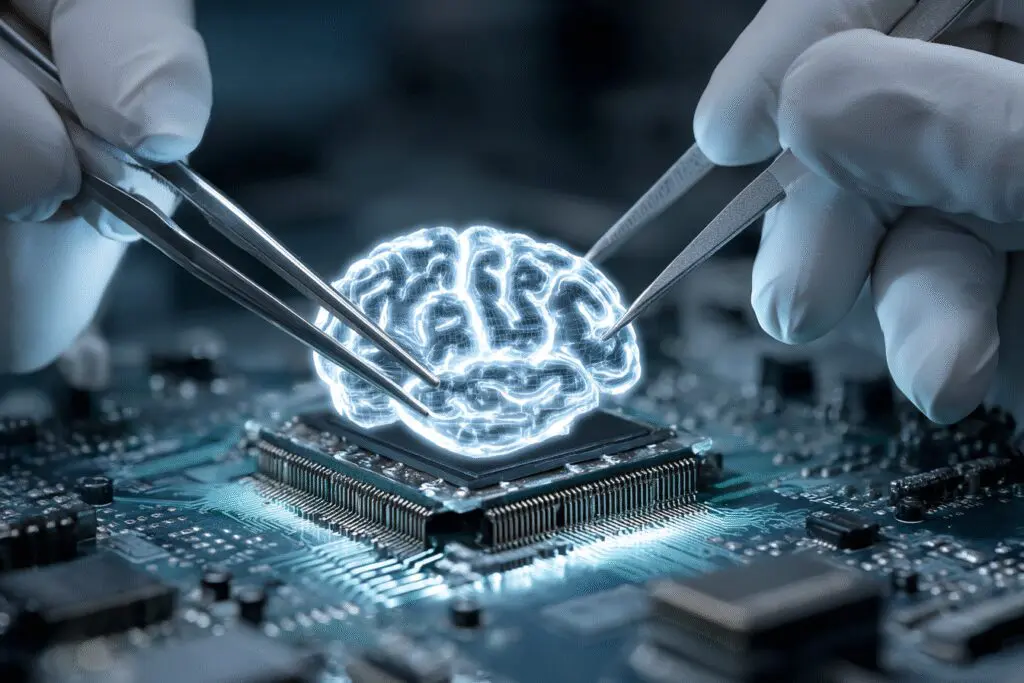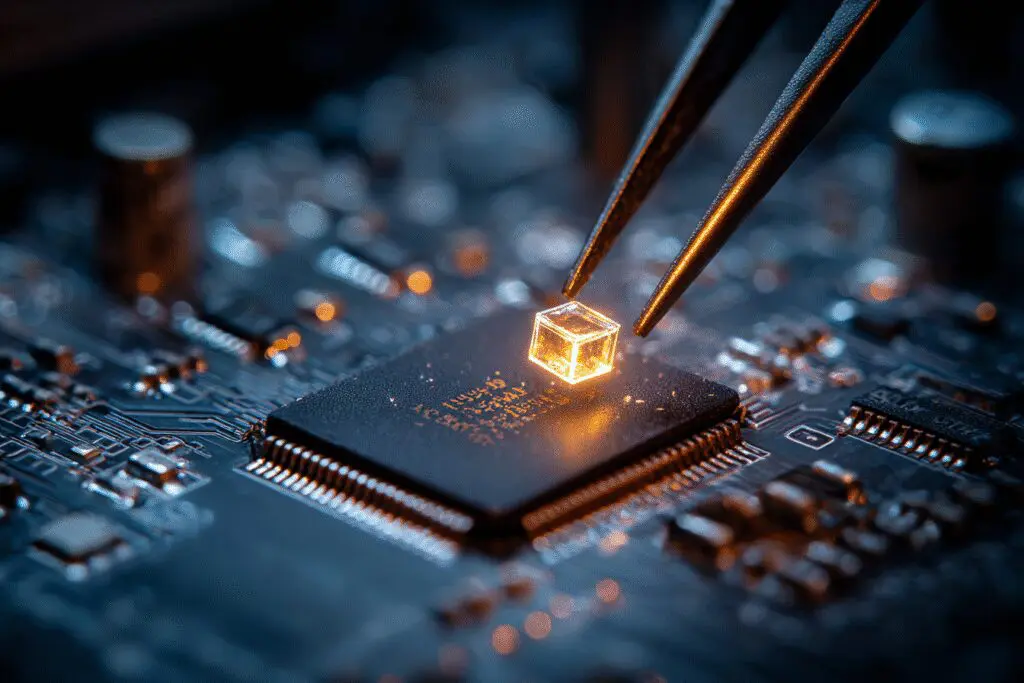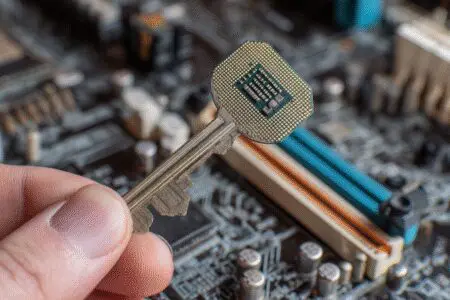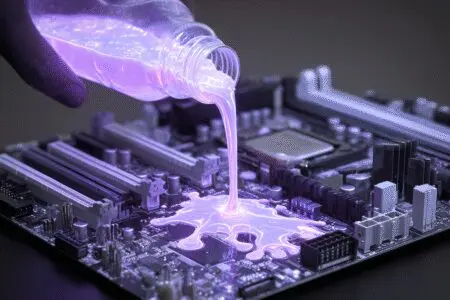For a second, I was convinced I had a DOA chip. Then, a faint memory surfaced of something I’d skimmed in a forum: older motherboards need a firmware update to recognize newer CPUs. That firmware, of course, is the BIOS. That whole ordeal taught me a crucial lesson about knowing how to update motherboard BIOS. It sounds like a high-stakes, terrifying task, but it’s actually pretty manageable when you take it one step at a time.
The BIOS (Basic Input/Output System) is the first thing that stirs when your computer boots up. It’s the little piece of code that pokes all your hardware awake—the CPU, RAM, storage—and gets them talking to each other.
On any PC built in the last decade, you’re actually dealing with UEFI (Unified Extensible Firmware Interface), which is just a fancier, friendlier version of the old BIOS. Most of us just stick with the old term. Think of it as the rock-bottom instruction manual for your motherboard. And like any software, it occasionally needs an update to learn new things, fix weird bugs, or patch up security holes.
This guide is meant to walk you through it all, from the prep work to the final, successful reboot. We’ll cut through the jargon and give you a safe, clear path to updating your PC’s most fundamental software without the stress.
More in Motherboards & Storage Category
Are External SSD Good for Gaming
Why Should You Even Bother Updating Your Motherboard BIOS?
Before we get into the how, we really need to talk about the why. You’ve probably heard the old tech wisdom, “If it ain’t broke, don’t fix it,” and honestly, that often applies to the BIOS. If your machine is humming along just fine, you can probably leave it alone.
That said, there are some really good reasons why an update goes from a “maybe” to a “definitely.”
What Are the Main Reasons to Update a BIOS?
- To Support New Hardware: This is the big one. Just like my story, manufacturers have to release updates so their older boards can communicate with shiny new processors. Without that update, the motherboard has no clue what that new chip is, and you get nothing but a black screen.
- To Improve System Stability: Updates frequently bring better memory stability. If you’re pulling your hair out trying to get your RAM to run at its advertised speed with XMP or DOCP, a BIOS update can be a miracle worker. They contain smarter algorithms that can make your whole system less prone to crashing.
- To Patch Security Holes: Manufacturers also use BIOS updates to fix bugs and plug security gaps. You might remember the Spectre and Meltdown scares a while back; those required BIOS-level patches to properly secure systems. It’s a critical part of keeping your computer safe.
- To Unlock New Features: Once in a while, an update will add cool new functionality. A recent example is Resizable BAR, a feature that can give your gaming performance a nice little boost with the right graphics card.
Will a BIOS Update Improve My PC’s Performance?
Everyone asks this, and the straightforward answer is usually no. A BIOS update isn’t going to magically boost your frame rates or make Photoshop launch faster. That’s not its job.
However, the indirect benefits can absolutely feel like a performance bump. If an update fixes an instability that was causing random blue screens, your PC is obviously going to run better. Likewise, if it finally lets your RAM run at its speedy 3600MHz instead of the sluggish 2133MHz default, you will notice a real difference. It doesn’t add horsepower, but it lets the engine run as it was designed to.
Is It Risky to Update the BIOS?
Let’s be real: there’s a tiny bit of risk. The biggest boogeyman is a power outage right in the middle of the flash. The process takes a few minutes, and if the lights go out while it’s writing the new BIOS to the chip, you can “brick” the motherboard. That means the core software is corrupted, and the board is basically a paperweight because it doesn’t know how to start itself.
Luckily, this is a solved problem on most modern motherboards.
What Safety Features Protect Against a Bad Flash?
Engineers have come up with some clever safety nets to make this whole process much less scary.
- Dual BIOS: Some boards literally have two BIOS chips. If you mess up the main one, you can flip a tiny switch on the motherboard, boot from the backup, and try again. It’s a fantastic safety net.
- USB BIOS Flashback (or Q-Flash Plus): This feature is a complete game-changer. It lets you update the BIOS with nothing more than a USB stick and a power supply. You don’t even need a CPU or RAM installed. This is what saved my bacon with that new Ryzen CPU. It’s the ultimate undo button.
Before You Begin: What Is The Essential Preparation Checklist?
Good preparation is 90% of the work here. Rushing this is a bad idea. Spend five minutes going through this list before you download anything.
- Know Your Exact Motherboard Model: You need the exact model and revision number (e.g., “TUF GAMING B550-PLUS,” not just “ASUS B550”). Using the wrong file is the fastest way to a dead motherboard.
- Get the Official BIOS File: Only download from the manufacturer’s support website for your specific model. Don’t trust files from forums or random third-party sites.
- Grab a Simple USB Drive: An old, small (4GB to 32GB) USB 2.0 drive is your best friend here. It needs to be formatted as FAT32.
- Read the Instructions: The download usually includes a text file with notes. Read it! It might have crucial info, like needing to update a chipset driver first.
- Make Sure Power is Stable: Don’t do this during a thunderstorm. If you own an Uninterruptible Power Supply (UPS), this is its moment to shine.
- Save Your Settings: Snap a few pictures of your BIOS settings screens with your phone. Any custom fan curves, boot orders, or overclocks will be wiped clean, and you’ll want to remember what they were.
How Do I Find My Exact Motherboard Model Number?
This is step one, and it’s the most important. Flashing the BIOS for a “Pro” model onto a “Plus” model is a guaranteed headache. Thankfully, finding your model name is easy.
How Can I Find My Motherboard Model in Windows?
My go-to method is a built-in tool called System Information. Just hit the Windows key, type msinfo32, and press Enter. A window will pop up. Look for “BaseBoard Manufacturer” and “BaseBoard Product.” That “BaseBoard Product” line is exactly what you need.
Another great tool is the free utility CPU-Z. Download it, run it, and click the “Mainboard” tab. It’ll show you the manufacturer, model, and your current BIOS version all in one spot.
Can I Find the Model Number on the Motherboard Itself?
Absolutely. The model name is always printed right on the circuit board, usually in big letters somewhere between the CPU and the graphics card slot. You might need a flashlight to see it in a dark case, but it’s there.
Why Is the Exact Model and Revision Number So Important?
Sometimes you’ll see a “Rev. 1.0” or “Rev. 2.0” on the board. Pay attention to this! Manufacturers sometimes make tiny hardware tweaks between revisions. Those tweaks often mean they need a completely different BIOS file. Using the wrong revision’s file is the same as using the wrong model’s file. Always double-check.
How to Update Motherboard BIOS: A Step-by-Step Guide
Okay, prep work is done. Time to get to it.
Step 1: Where Do I Download the Correct BIOS File From?
Go to the support website for your motherboard’s brand (ASUS, Gigabyte, MSI, ASRock, etc.). Find the support page for the exact model you wrote down. Look for a “Downloads” or “Drivers” section, and within that, a “BIOS” or “Firmware” category.
You’ll probably see a list of versions. It’s usually best to grab the latest non-beta version. Read the release notes—they tell you what each update does. Download the file, which will come as a ZIP archive.
Step 2: How Should I Prepare the USB Drive for a BIOS Update?
Plug in your USB drive. It absolutely must be formatted as FAT32. To do this in Windows, open File Explorer, right-click the drive, and hit “Format.” Choose “FAT32” from the dropdown menu and click “Start.” This will wipe the drive, so make sure there’s nothing important on it.
Now, unzip the file you downloaded. Inside, you’ll find the BIOS file. It’ll have a weird name and extension, like E7C91AMS.A80. This is the file you need. Copy just that single file to your clean USB drive.
Important Tip: Some brands require you to rename the file to something specific for the update to work. For instance, ASUS might need it to be M13H.CAP. This info will be in the manual or on the download page, which is why reading that stuff is so important!
What is the Best USB Drive to Use for a BIOS Update?
Keep it simple. A basic, boring USB 2.0 drive with a small capacity (8GB or 16GB) is perfect. The simple brain in the BIOS can sometimes get confused by fancy, high-speed USB 3.0 drives. I have a single 8GB drive I use for nothing else.
Step 3: How Do I Enter the BIOS/UEFI Menu?
With the USB drive plugged into a port on the back of your PC (directly on the motherboard), restart your computer. The second it starts to boot, begin tapping the key to enter the setup menu. It’s usually Delete or F2. The boot screen will flash the correct key for a second.
Should I Reset to Optimized Defaults Before Flashing?
Yes, absolutely. It’s a great habit to get into. Any custom overclocks can sometimes cause issues during the flash. Find the option to “Load Optimized Defaults” (usually on the “Exit” tab), select it, and save. The PC will restart. Just enter the BIOS again, and you’ll be starting from a clean slate.
Step 4: Where Can I Find the Flashing Tool in the BIOS?
Every brand has its own name for the update utility. You’re looking for something in the “Tool” or “Advanced” menus called:
- ASUS: EZ Flash 3
- MSI: M-Flash
- Gigabyte: Q-Flash
- ASRock: Instant Flash
When you launch it, it will let you browse the files on your USB drive.
Step 5: What Does the Actual Flashing Process Involve?
Find and select the BIOS file you copied to your USB drive. The utility will check it to make sure it’s the right one and show you the current version versus the new one. This is your last chance to back out.
Once you hit “confirm,” it will start. A progress bar will appear. THIS IS THE MOMENT OF TRUTH. Don’t touch anything. Don’t even breathe on it too hard. Just let it work. It can take a couple of minutes.
When it’s done, the computer will restart on its own. The first boot can be a little slow as it re-initializes everything, so give it a minute.
How to Update Motherboard BIOS if the PC Won’t POST?
This is where USB BIOS Flashback saves the day. If your PC won’t even boot because the CPU is too new, this is your move. You prepare the USB drive with the specially renamed file. Then, with the PC off, you plug the stick into a specific USB port on the back (it’s usually labeled “BIOS”). You press a little button next to it, and an LED starts blinking. When the light stops, the update is done. It’s magic.
What Should I Do After the BIOS Update is Complete?
You made it! The PC has rebooted. You’re almost done. The update wiped your settings back to factory defaults, so you have to pop back into the BIOS one last time.
Why Do I Need to Reconfigure My BIOS Settings?
The update installs a totally fresh copy of the firmware, and carrying over old settings could cause conflicts. It’s a safety measure. Here’s what you need to set back up:
- Enable XMP/DOCP: This is the most important one! Your fast RAM is running at its slowest default speed until you turn its profile back on.
- Set the Boot Order: Tell the motherboard which drive has Windows on it. Go to the “Boot” tab and put your main SSD or NVMe drive at the top of the list.
- Adjust Fan Curves: If you had custom fan speeds, you’ll need to redo them.
- Enable Resizable BAR/Smart Access Memory: If you have compatible hardware, don’t forget to flip this back on for a little extra gaming performance.
How Can I Verify the Update Was Successful?
Easy. While you’re in the BIOS, the main screen will show the new BIOS version number. You can also boot into Windows, run CPU-Z, and check the “Mainboard” tab. It will confirm the new version is installed.
A Personal Story: Why Is Preparation So Important?
I want to share a quick story that hammers home the importance of prep. I was helping a buddy with his first PC build. We got it all together, and it turned on, but his new NVMe SSD was nowhere to be found in the BIOS. We were totally stumped.
After some frantic Googling, we found a forum post about how the board’s original BIOS had trouble with some NVMe drives. An update was the fix. My friend, eager to get it working, downloaded the file, threw it on a USB, and tried to flash. The utility couldn’t see the file. He tried a different port. A different drive. Nothing.
He was getting really frustrated. I finally asked him, “How did you format the drive?” He just stared at me. It was a new 128GB drive formatted as exFAT out of the package. The BIOS couldn’t read that file system. We reformatted it to FAT32, copied the file back over, and boom—the flash utility saw it instantly. Five minutes later, the PC rebooted, and the drive was there. A tiny, overlooked detail was the only thing holding us back.
Understanding the Risks: When Should I NOT Update My BIOS?
As important as updating can be, sometimes the best move is to do nothing. If your PC is running perfectly, all your hardware is recognized, and you don’t need any of the fixes in the update notes, there’s no reason to risk it. Don’t update just for the sake of updating.
The BIOS is a powerful, low-level piece of software. As the computer science folks at the University of Colorado Boulder explain, firmware is the special code that gives hardware its basic instructions. It’s the essential link between the physical parts and your operating system.
In the end, it’s a simple cost-benefit question. Is the benefit of supporting a new CPU or patching a security flaw worth the tiny risk of a power outage? Most of the time, if you need the update, the answer is a clear yes—as long as you’re careful and prepared.
Updating your BIOS is a task that feels way scarier than it is. It’s a process that demands a bit of respect and preparation, not fear. By taking your time, double-checking your model, and following the steps on how to update motherboard BIOS, you can handle this upgrade with confidence. And the satisfaction of seeing your PC boot up with its newly updated brain is a great feeling for any builder.
Frequently Asked Question

What are the risks of updating my motherboard BIOS and how can I minimize them?
The main risk is the update failing due to power loss or interruption, which can ‘brick’ the motherboard. To minimize this risk, use a reliable power source, follow the instructions carefully, and ensure the process is not interrupted.
Does updating the BIOS fix bugs and improve stability?
Yes. BIOS updates often include fixes for bugs, security vulnerabilities, and stability issues that can cause crashes or hardware malfunctions.
Why might I need to update my BIOS to support a new CPU?
Updating the BIOS is necessary to support a new CPU because the update provides the motherboard with the needed information to recognize and properly operate the new processor.
Can BIOS updates actually improve my PC’s performance?
Yes, a BIOS update can help your PC’s performance by enabling your RAM to run at full speed and providing your CPU with new instructions for better efficiency.
Why is it important to learn how to update motherboard BIOS?
Learning how to update your motherboard BIOS is important because it can improve performance, add new features, fix bugs, and enhance stability and security of your PC.





